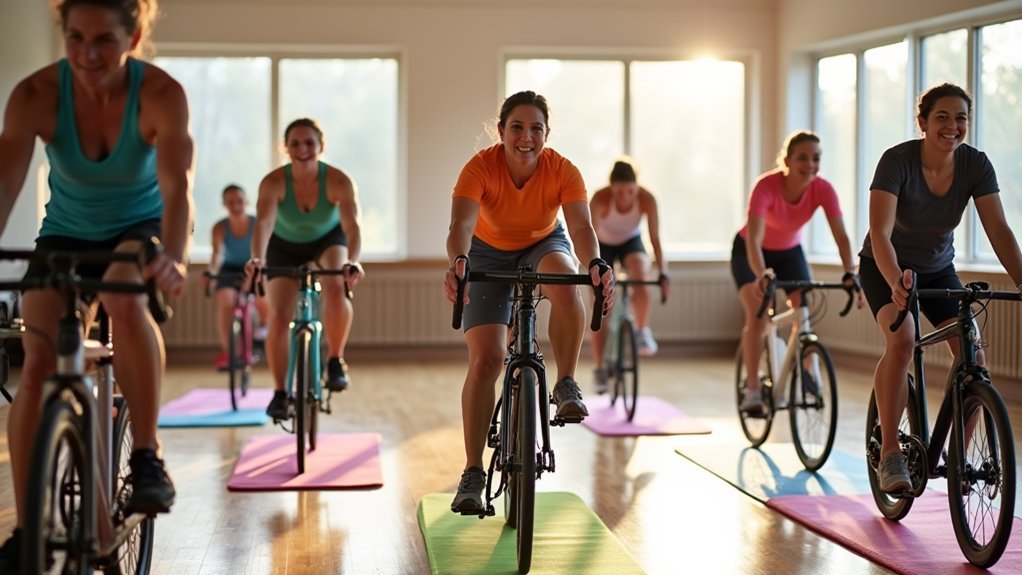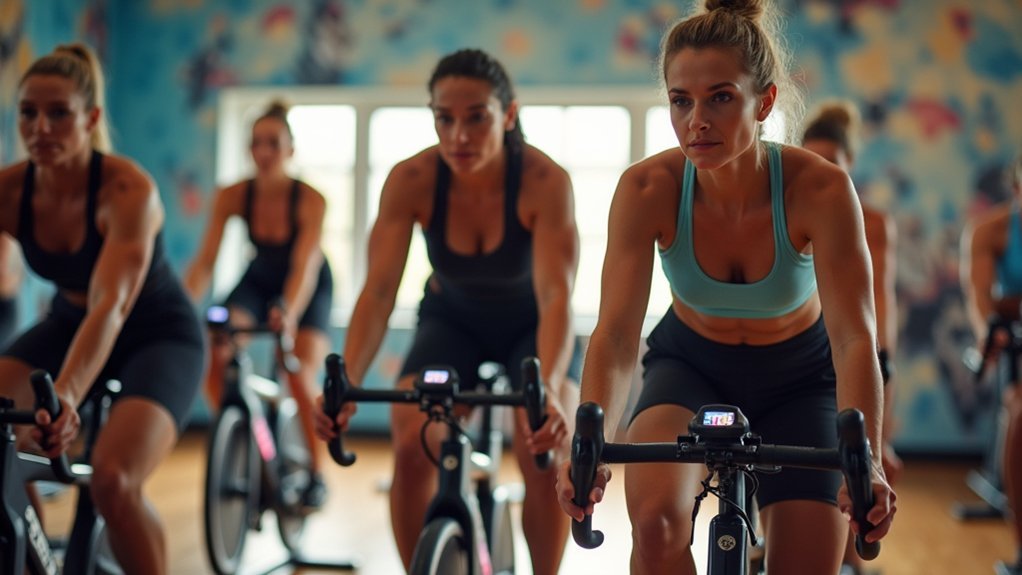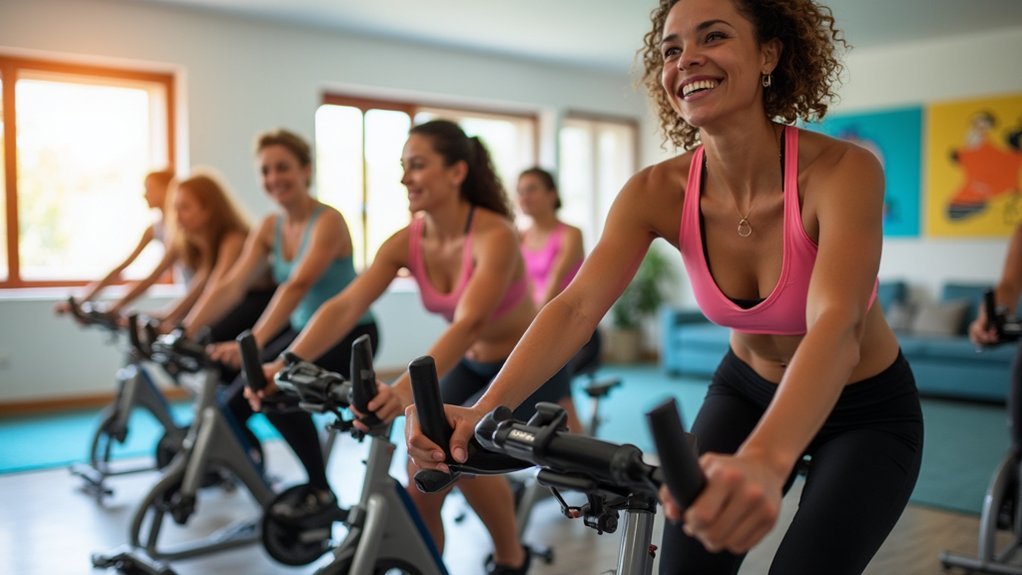Indoor cycling offers you a joint-friendly workout with minimal impact on knees, hips, and ankles while still providing cardiovascular benefits. You’ll find adaptive equipment like recumbent bikes with back support and adjustable resistance levels to match your abilities. The seated position eliminates balance concerns and fall risks, while climate-controlled environments guarantee year-round access regardless of weather. Supportive communities and specialized instructors can help you build confidence as you strengthen muscles without strain. Discover how therapeutic cycling might transform your mobility journey.
Low-Impact Exercise for Joint-Friendly Workouts

While many forms of exercise can strain sensitive joints, indoor cycling stands out as a remarkably joint-friendly option for those facing mobility challenges.
As a low impact activity, it minimizes stress on your knees, hips, and ankles while still delivering an effective workout.
The smooth pedaling motion actually enhances joint lubrication, particularly in the knees, which can reduce stiffness and pain if you’re dealing with conditions like arthritis.
You’ll strengthen the muscles surrounding your joints without risking high-impact strain, which supports overall joint health and preserves mobility.
What makes indoor cycling particularly accessible is how easily you can control resistance and pace.
You can start with just 10 minutes daily and still experience improved joint mobility while gradually building strength at your own comfort level.
Adaptive Equipment for Different Mobility Needs
Indoor cycling’s accessibility extends beyond its gentle nature with an impressive range of adaptive equipment designed to accommodate various mobility needs.
Indoor cycling offers more than gentle exercise – it provides specialized equipment that works for bodies of all abilities.
If you’re facing balance issues, adaptive bikes like recumbent models and tricycles provide enhanced stability and support, making your workout safer and more effective.
For those with limited strength, e-bikes with pedal assistance prevent overexertion while extending your riding range.
Handcycles offer excellent options if you have restricted leg mobility, allowing you to build upper body strength while enjoying cardiovascular benefits.
Comfort remains essential for successful workouts.
Adjustable bike seats and handlebars can be customized to your specific requirements, while specialized indoor cycling equipment featuring wider seats and lower frames guarantees accessibility regardless of joint limitations or injury recovery status.
Customizable Resistance for Progressive Strength Building

Customizable resistance on indoor cycling bikes gives you complete control over the intensity of your workout, allowing you to start with minimal tension that won’t stress your joints.
You’ll find the ability to adjust resistance levels empowers you to build strength gradually as your muscles adapt to the increasing demands of each session.
Your personalized training progression can be tailored precisely to your mobility needs, ensuring you’re always working at the ideal level for strength development without risking injury.
Adjustable Tension Levels
One of the most empowering features of indoor cycling bikes comes from their adjustable tension systems, which allow you to precisely control your workout intensity.
If you’re facing mobility challenges, these customizable resistance options provide a pathway to build strength safely at your own pace.
- You’ll find multiple resistance levels that adapt to your current abilities
- You can gradually increase difficulty as your strength and endurance improve
- The controlled tension minimizes joint strain while maximizing muscle engagement
- You’ll experience the benefits of progressive resistance training, shown to improve joint function
- Instructors can guide you on ideal tension adjustments for your specific needs
This safe workout approach guarantees you’re challenged appropriately without overexertion, making indoor cycling an excellent exercise option regardless of your mobility limitations.
Strength Without Joint Stress
Unlike high-impact exercises that can strain sensitive joints, indoor cycling offers a remarkable pathway to build strength without the accompanying stress on your body.
You’ll experience true strength training benefits while protecting vulnerable joints from unnecessary pressure.
By customizing resistance levels, you can progressively build lower body strength at your own pace. Your quads, glutes, hamstrings, and calves all engage effectively during each session without the joint stress that often accompanies traditional weightlifting.
The gentle, rhythmic pedaling motion actually enhances joint lubrication, helping to improve mobility over time.
With just three weekly classes, you’ll greatly boost bone density while strengthening critical muscle groups.
This makes indoor cycling particularly valuable if you’re managing arthritis, recovering from injury, or simply seeking a safer approach to building functional strength.
Personalized Training Progression
The true magic of indoor cycling emerges through its highly personalized approach to building strength. When facing mobility challenges, you’ll find the adjustable resistance on the bike becomes your greatest ally in creating a training progression that’s uniquely yours.
- Start with lower resistance settings to establish core strength without strain
- Gradually increase intensity as your muscle endurance improves
- Target specific muscle groups by customizing resistance patterns
- Control your workout intensity regardless of physical limitations
- Track your progress with measurable resistance increases over time
This personalized training progression allows you to safely challenge yourself at your own pace.
Whether you’re recovering from an injury or managing chronic mobility issues, you can improve muscle endurance steadily while respecting your body’s limitations—building functional strength that translates to better mobility in everyday life.
Seated Stability Without Balance Concerns

For individuals with mobility limitations, indoor cycling offers a significant advantage through its inherently stable seated position. You’ll find that this seated workout eliminates the risk of falling while still delivering an effective exercise experience. If you’re dealing with joint issues, the stationary bike’s solid structure lets you focus entirely on pedaling without worrying about maintaining balance.
| Benefit | For Mobility Challenges | How It Helps |
|---|---|---|
| Stability | No risk of falling | Builds confidence |
| Control | Adjustable resistance | Customized intensity |
| Support | Fixed seating position | Reduces balance demands |
| Comfort | Seated exercise | Minimizes joint strain |
| Progress | Gradual strength building | Improves mobility over time |
The bike’s design accommodates different abilities while still engaging major muscle groups effectively. You’ll develop strength and endurance without the high-impact stress that comes with many other exercise options.
Cardiovascular Benefits Without High-Impact Stress
While high-impact exercises can stress vulnerable joints, indoor cycling offers robust cardiovascular benefits without these risks.
You’ll strengthen your heart and improve circulation through this low-impact activity that’s specifically designed for those with mobility limitations.
- Enhances cardiovascular health by increasing aerobic capacity without jarring movements
- Supports weight management through significant calorie burn during rhythmic pedaling
- Improves joint mobility as the cycling motion lubricates joints without straining them
- Promotes better circulation through sustained elevated heart rate in a controlled environment
- Builds endurance and stamina at your own pace without fear of injury
Your heart benefits from the consistent workout while your joints remain protected—a perfect combination for maintaining fitness despite mobility challenges.
Supportive Communities for Motivation and Encouragement
When you struggle with mobility limitations, maintaining exercise motivation can feel overwhelming, but indoor cycling communities transform this solitary challenge into a shared journey.
Specialized classes designed for people with mobility challenges create welcoming environments where you’ll find supportive instructors and fellow riders cheering you on.
The collective energy in these classes makes committing to your fitness goals easier, even on difficult days.
You’ll discover that leaderboards foster friendly competition, helping you set and achieve personal milestones.
Beyond physical benefits, you’re likely to form meaningful friendships and support networks that provide emotional encouragement.
These connections enhance your overall well-being and help you maintain consistency in your fitness routine—proving that indoor cycling delivers both physical improvement and valuable community support.
Indoor Climate Control for Year-Round Accessibility
The protective embrace of indoor cycling extends beyond supportive communities to the physical environment itself. When you’re dealing with mobility limitations, the climate-controlled environment of an indoor cycling studio becomes a vital advantage for maintaining a consistent workout routine.
- Exercise comfortably regardless of extreme heat, cold, or inclement weather
- Reduce risk of temperature-related health issues like overheating or hypothermia
- Benefit from customized lighting and ventilation systems if you have sensory sensitivities
- Maintain your fitness momentum with year-round accessibility
- Exercise safely without worrying about environmental hazards like uneven terrain
Indoor cycling creates a stable, controlled setting where you can focus entirely on your workout without the unpredictability of outdoor conditions.
This reliability is particularly valuable when managing mobility challenges that require careful attention to your exercise environment.
Modified Techniques for Various Physical Limitations
When you’re facing mobility challenges, adaptive seating solutions like recumbent bikes provide essential back support while allowing you to maintain proper form.
You’ll find low-impact pedaling techniques particularly beneficial, as they reduce joint strain while still delivering cardiovascular benefits through controlled resistance adjustments.
Specially designed handlebars offer extra stability options, letting you customize your grip position for balance and comfort throughout your indoor cycling session.
Adaptive Seating Solutions
Finding comfort on an indoor cycle can transform the exercise experience for those with mobility challenges. Adaptive seating solutions make indoor cycling more accessible and enjoyable, regardless of your physical limitations.
- Wider seats and adjustable backrests reduce strain while providing essential support during your workout.
- Specialized bikes with low step-through frames make mounting and dismounting safer and easier.
- Gel seat covers and padded bike shorts greatly improve comfort for those with sensitivity concerns.
- Recumbent bikes offer a relaxed position, ideal if you have balance issues or limited mobility.
- Arm pedals and hand cycles create inclusive options if you experience lower body mobility limitations.
These modifications guarantee indoor cycling remains a viable exercise option, allowing you to enjoy its cardiovascular benefits while accommodating your unique physical needs.
Low-Impact Pedaling Techniques
Now that you’ve found the right seating setup, mastering proper pedaling techniques becomes your next step toward successful indoor cycling. Low-impact pedaling techniques can transform your exercise experience, particularly when mobility is a concern.
| Technique | Benefit |
|---|---|
| Use adjustable resistance | Controls intensity to match your comfort level |
| Choose recumbent bikes | Provides better back support and stability |
| Start with 10-15 minute sessions | Builds endurance without overwhelming your body |
| Perform gentle warm-ups | Prepares muscles and reduces risk of injury |
| Adjust the seat properly | Guarantees slight knee bend at lowest pedal position |
Remember to adjust the seat to your specific height requirement. A properly positioned stationary bike allows for smooth, natural pedaling motion while reducing strain on your joints. These modifications help reduce the risk of discomfort while maximizing the benefits of your cycling routine.
Handlebars for Stability
Proper handlebar positioning serves as the foundation for maintaining balance during indoor cycling, especially if you’re managing physical limitations. The right handlebar setup can dramatically improve your stability and confidence while adapting to your unique mobility needs.
Consider these stability-enhancing approaches:
- Opt for wider handlebars that provide greater control for balance challenges.
- Use adjustable handlebars to customize height and angle for maximum wrist and shoulder comfort.
- Choose bikes with lower step-through frames for easier access to handlebars.
- Apply a light, neutral grip to maintain stability while keeping your upper body relaxed.
- Explore modified grip techniques like additional handlebar attachments if you have limited upper body strength.
These modifications guarantee you’ll experience a safer, more comfortable ride while addressing your specific mobility considerations during indoor cycling sessions.
Therapeutic Cycling for Rehabilitation Progress
When commencing on a rehabilitation journey, therapeutic cycling stands out as a versatile and effective approach for rebuilding strength and function. You’ll find that even 10-minute daily sessions can greatly improve knee joint strength and reduce pain from stiffness.
| Benefit | How Therapeutic Cycling Helps |
|---|---|
| Joint Health | Enhances mobility and lubrication |
| Pain Management | Alleviates discomfort from arthritis |
| Strength Building | Boosts muscle endurance gradually |
| Controlled Progress | Allows self-paced resistance adjustment |
Low-impact cycling provides a safe way to maintain consistent physical activity—crucial for preserving mobility as you age. The adjustable resistance of indoor cycling makes it ideal if you’re recovering from injuries or managing chronic conditions. By incorporating therapeutic cycling into your rehabilitation program, you’ll experience improved overall mobility and quality of life.
Frequently Asked Questions
Does Cycling Improve Mobility?
Yes, cycling improves your mobility by lubricating knee joints, strengthening lower body muscles, and reducing joint stress. Even short 10-minute sessions can greatly enhance your movement capabilities and provide pain relief when you’re experiencing stiffness.
What Are the Benefits of Indoor Cycling?
You’ll enjoy improved cardiovascular health, increased lower body strength, and enhanced endurance with indoor cycling. It’s a low-impact workout that won’t strain your joints while burning calories and reducing stress effectively.
Why Do People Do Indoor Cycling?
You do indoor cycling for its low-impact cardiovascular benefits, convenient schedule, and community atmosphere. It’s an efficient way to burn calories, build leg strength, and improve endurance regardless of weather conditions.
What Is the 75 Rule in Cycling?
The 75 rule suggests you should spend 75% of your training time in moderate to high intensity heart rate zones. It’s designed to optimize your cardiovascular benefits while still allowing for necessary recovery periods.
In Summary
Indoor cycling offers you a versatile, accessible workout regardless of your mobility challenges. You’ll find joint-friendly exercise with adaptable equipment that works with your specific needs. Don’t worry about balance—you’re securely seated while building strength at your own pace. You’re joining a supportive community in a climate-controlled environment that’s available year-round. Whether you’re rehabilitating or maintaining fitness, cycling’s personalized approach makes movement possible for everyone.





Leave a Reply